Norway: Home of the Giants

'Rauddalen (\"Red Valley\") (Photo by Vegard Roine Stenerud)'
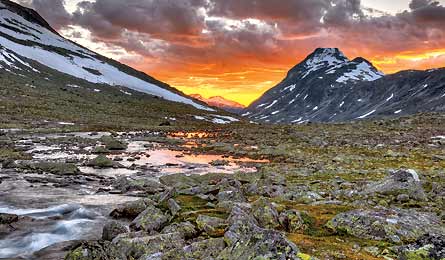
Rauddalen (“Red Valley”) (Photo by Vegard Roine Stenerud)
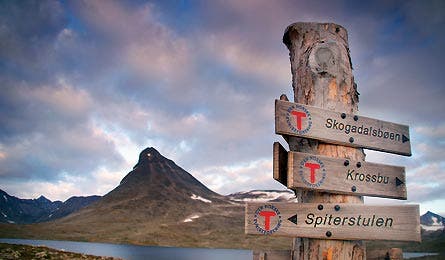
Trail Junctions are well marked (Photo by Blick Winkel/AGE Fotostock)
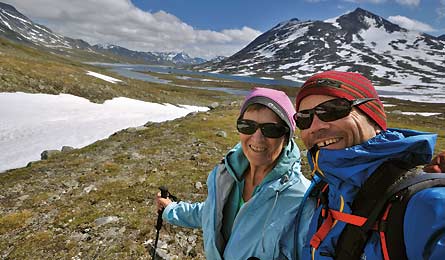
Author with his Mom (Photo by Michael Lanza)
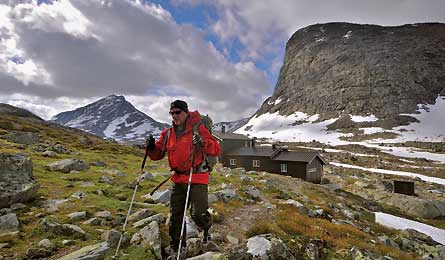
Jeff Wilhelm Leaving Olavsbu Hut (Photo by Michael Lanza)
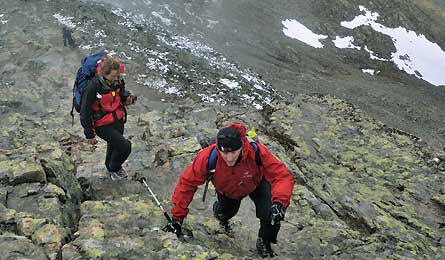
Scrambling up Besseggen Ridgen (Photo by Michael Lanza)
On a treeless tundra plateau deep in Norway’s Jotunheimen National Park, we stop before a bouncy suspension bridge over a snarling whitewater river. I shoot a glance at my 75-year-old mom. In a tone that contains more fatalism than enthusiasm, she reminds me, “I’ve never crossed one of these.”
I nod and calmly, maybe a little enthusiastically, assure her, “You can do this.” But the flushed look on her face tells me she’s not buying that line. I don’t need reminding that I planned this weeklong trek—and convinced my mom she’d be OK. “Trust me,” I’d said, “I know you can make it.”
My confidence is not unfounded. I like to refer to my mom as The World’s Toughest Grandma. She didn’t even start hiking until her late 40s, when I first got her on the trail. After early forays up New Hampshire’s Mt. Monadnock, we moved on to bigger adventures together, ranging from a hut traverse of the Presidential Range to backpacking in the Grand Canyon. But she’s never attempted anything as long or hard as this 60-mile trek.
It’s day two of our hut-to-hut journey through Jotunheimen, and we’ve been hiking for five hours across a rugged, Arctic-looking landscape vibrantly colored with purple mosses and yellow wildflowers. Cliffs and mountains look like they were chopped from the earth with an axe. Lichen blankets glacial-erratic boulders. It’s beautiful, to be sure, but rain and near-freezing temperatures have also made it a trial; the weather alone would be hard on anyone. Now here’s this swaying bridge—which must feel like a wobbly slackline to my septuagenarian mother—over a raging river.
Our multi-generational group eyeballs the span. In addition to my mom, Joanne, the crew includes my wife, Penny; our 11-year-old son, Nate, and 9-year-old daughter, Alex; plus friends Jeff Wilhelm and his 20-year-old daughter, Jasmine.
The others get moving. Nate deliberately bounces the bridge like a diving board as he crosses. (Not helping, Nate! I want to yell.) Alex inches cautiously across. My mom still looks like she might turn around and march in the other direction.
I recall another hike when I saw that same unhappy expression. On a trip to Yosemite, when she was a youthful 58, she and I sat at the base of the cable route on Half Dome while she contemplated scaling several hundred feet of dizzyingly steep granite. We sat for half an hour in silence. Then she jumped to her feet and declared, “OK, let’s go.” A little while later, we stood atop Half Dome, her anxious grimace replaced by a beaming grin of disbelief.
On this trip, I hope to see that smile of triumph again. Now I wonder: Have too many years gone by? Can she still make that leap of faith?
Jotunheimen—which translates as “Home of the Giants”—contains the highest European mountains north of the Alps, starkly barren peaks rising to more than 8,000 feet and blanketed with thick, crack-riddled glaciers. Braided rivers meander down mostly treeless valleys, and reindeer roam wild. But best of all, a trek in Jotunheimen combines that pristine wilderness with Europe’s most luxurious huts, as well as flexible route options and side trips. It seemed perfect for a group like ours, with a wide range of ages and abilities.
One small wrinkle: Thanks to an unusually cold summer, much of the ground here remains snow-covered in late July. And rather than the average summer highs in the 50s, the forecast calls for days of rain, wind, and temperatures in the 30s.
Indeed, we had to implement Plan B on our trek’s first morning. At Gjendesheim, a hotel masquerading as a hut on the shore of Gjende, an 11-mile-long finger lake, we awoke to cold rain. My mom, kids, and Penny reached a quick consensus that the 30-minute ferry across Gjende to our next hut, Memurubu, looked like a fine alternative to battling the weather. Meanwhile, Jeff, Jasmine, and I put on our shells and set out to hike 10 miles to Memurubu via Besseggen Ridge.
Often called “the most famous hike in Norway,” Besseggen is one of those iconic places that’s sure to draw a crowd on a nice summer day. In blowing rain and snow, though, we saw almost no one. Amazingly, we still got to enjoy the famed scenery. Midday, the clouds lifted like a stage curtain, revealing snowy mountains rolling away to far horizons. Before us, Besseggen Ridge tilted sharply downward and narrowed to a gooseneck land bridge separating emerald Gjende from another lake, the hypnotically blue Bessvatnet. The seemingly improbable sculpturing of earth and water stirred the same awe I’ve felt in places like Patagonia and Iceland. For a moment, I wished my family were with me.
But only for a moment. As we scrambled down several hundred feet of exposed, rain-slick ledges, I had an anxious vision of trying to lead my family through this hairy stretch in these hypothermia-inducing conditions. The thought unsettled me. What if the rest of the week brought more of the same? They couldn’t take a shortcut every day.
I chose Jotunheimen looking for the wildest adventure I could do with my kids and mom—and have them like it. At the end of the first day, I was still confident they’d make it. But afterward, would they like me?
The World’s Toughest Grandma isn’t about to let her grandchildren show her up. So after Nate and Alex cross the suspension bridge, she steels herself and goes for it. She moves slowly, stepping gingerly to minimize any bouncing. Watching her, I marvel at her ability to go far outside her comfort zone at an age when most people just want comfort.
After crossing the bridge, we descend a hillside of boulders and ground-hugging greenery, hiking past jet-engine-loud waterfalls. In a steady shower, we walk beside another long, narrow lake framed by naked hills.
While my mom walks with Penny, I quicken my pace to catch up with Nate and Alex. Closing the gap, I recall a family trip we took to the Columbia River Gorge last summer, also with my mom. At 74, she hiked 12 miles to Tunnel Falls and, the next day, seven miles and 2,800 feet up Dog Mountain. On that trip, my 8-year-old daughter couldn’t keep up with her grandmother. In Jotunheimen, though, Alex’s pace eclipses her elder’s. My mom hasn’t slowed much in a year; Alex has leapt forward. As much as I feel joy and pride at seeing my kids grow more capable, I feel a pang of sympathy for my mother. She can’t help but confront this generational changing of the guard, as inevitable as rivers flowing downhill. The sight of my kids pulling away from her has a disorienting effect on me as well: It feels like I’m looking simultaneously in opposite directions, into my own past and future.
I was in my early 20s when I first took my mom on a hike. I was single and steering hard into a lifelong passion for the mountains; she was a middle-aged mother with only two of five children out of college. At a time in life when many young adults and their parents grow more distant, my mom and I found something to bring us closer.
Over the decades, even after I married and had kids of my own, we still made time for two or three annual trips. We’d hike and talk about family, books, and recipes, as well as harder subjects, like her wishes for the end of her life. Those times entered a lockbox of memories—which will someday be my most prized legacy from her. And they inspired me to take my children on regular father-son and father-daughter trips of our own.
My kids and I pull ahead of the others through a cold, steady rain, and we’re the first to arrive at Fondsbu hut, on the shore of Bygdin lake. Inside, we all peel off wet clothes and feel warmth creep back into our bodies.
At dinner, boisterous trekkers fill every chair in the hut’s 67-seat dining room for two sittings. They’re mostly Norwegians drinking heartily and bellowing “skol!” at frequent intervals. We dig into salad and bread followed by turkey with home-fried potatoes and vegetables—and for dessert, chocolate mousse with sorbet. Then Sjølborg Kvålshaugen, the hut warden, stands before the packed room, hands clasped. Six feet tall and strong-looking—with a beautiful voice that stills the crowd—she sings, a cappella, the jazz classic “Whenever We Say Goodbye.”
The warmth and food and good cheer lift everyone’s spirits. But after dinner, Kvålshaugen informs me that most of the way to our next hut is snow-covered, and tomorrow’s forecast calls for rain and temps barely above freezing. At our bunks, I share this news with the others. My mom says nothing, her smile gone; Nate and Alex burrow inside their sleeping bags.
That’s just how a mutiny begins: when they don’t talk to you.
Given the forecast, we unanimously agree on hunkering down for another night at Fondsbu—the park’s numerous trail options let us easily shave a trail day and one hut from our original itinerary. While the others read, play games, drink hot cocoa, eat chocolate, nap, and generally exult in the comfort of the hut’s two spacious living rooms, Jasmine, Jeff, and I again suit up for the worst that Norway can throw at us. We head out for a four-hour hike past icy lakes and white cascades, below dark mountains that occasionally peek through the gray fog—enjoying every moment. Knowing a hut awaits has a way of making miserable weather seem beautifully mystical.
But that rain delay will have to be our last mulligan. Any more days off will affect our reservations at later huts. So we hit the trail again on our fourth morning, in a cold wind and intermittent rain on a 10.5-mile, mostly uphill hump from Fondsbu to Olavsbu hut. Alex, Nate, and my mom happily deploy the three trekking umbrellas I brought, but the wind keeps inverting them and threatening to Mary Poppins my featherweight children to Sweden.
The next morning, the sun finally shatters the persistent overcast. Everyone walks with a quicker, lighter step as we pass beneath blades of gray rock that carve into the oceanic sky. My mom is doing great, clearly enjoying the scenery. Then we come to another stream crossing. The river-rich route presents numerous fords, and most hikers will cross them easily. But for a 75-year-old, the pushy water and slick rocks pose a real and potentially hazardous challenge. This one—100 feet across, swift, calf-deep, achingly cold with snowmelt, its bed paved with cobblestones—looks harder-than-average. A walkway of rocks, some slightly submerged, offers a route across that would save us from the numbing water—if everyone can avoid falling in.
I survey the expressions on my family’s faces: Nate, eagerness; Alex, uncertainty; my mom, mortal dread. I tell everyone that I’ll lead the kids and my mom across one at a time—quietly hoping we don’t end up with any broken bones or frigid immersions.
“Can I follow you first, Dad?” Nate pleads. Using our poles for balance in the tugging current, my son and I step carefully from stone to stone, some gaps requiring long, awkward strides. Nate stays focused and silent. At the opposite bank, the pent-up thrill explodes from him. “That was exciting!” he exclaims.
I return to guide Alex. I’m a little worried, but needn’t be—she knocks it off as confidently as her brother, reminding me yet again how much my kids have blossomed into seasoned backcountry travelers.
Then it’s my mom’s turn. She mutters her displeasure, but fixes the stream with a look I’ve seen before. It says, “Don’t push your luck with me.” Someday, when my mom puts away her boots for good, it won’t be her attitude that fails her. She attacks the crossing, shifting her weight from one slippery rock to the next, stretching and bending like a venerable yogi. Just before reaching the other side, she slips—and my pulse leaps. But she catches herself, only dunking one boot. Those balance exercises she does at her health club have really paid off.
Beyond the stream, we encounter no more serious challenges and the terrain gets gentler. We walk in warm sunshine up a rock- and tundra-carpeted valley, below muscular mountains speckled with snowfields, past lakes choked with plates of broken-up ice. Beyond a low pass, we descend gentle, stress-free slopes of soft snow, toward another lake and the most opulent hut of our trek, Leirvassbu.
In our private rooms, with a view of the lake and mountains, Nate—not normally a paragon of personal hygiene—dashes for the shower. He soaks for a solid 15 minutes and emerges burbling, “That was absolutely amazing.” I check in on the girls’ room: all smiles.
Later, in the spacious dining hall, we relax with a round of beer and wine and an appetizer of skinke, a prosciutto-like meat, served with potato and egg. After a salmon dinner followed by—incredibly—strawberries and ice cream, it appears everyone has made a full recovery. Proof positive: When the conversation shifts to that stream crossing, even mom is laughing.
By early afternoon on our sixth day, we’re descending a snow-free valley, with just a few more hours of dry, easy hiking to our last hut, Spiterstulen. Frothing streams gray with glacial flour crash into an emerald river. Pyramidal peaks vault skyward. At one point, we count seven glaciers within view. Under a clear sky, the temperature leaps above 50°F, a veritable heat wave. For the first time all week, I change into shorts and a T-shirt. Jeff and Jasmine proclaim this “the most idyllic day of hiking” they’ve ever had.
But was this glorious day worth the week’s challenges for my mom? I walk with her, away from the others, and confess, “I feel badly for dragging you out here. I didn’t think it was going to be this hard.”
“I like being out here,” she responds without hesitation. “I like the walking.” Then she ticks off what for her were the hard parts—the stream crossings, the harsh weather, the need to keep moving. Of course, those are the rigors of many multiday treks.
We both understand that she may have crossed a threshold. Will we look back on this week as our last big wilderness trek together? We know that day will come at some point, and neither one of us looks forward to it. But the real tragedy would have been if we never started hiking together in the first place.
Back in my 20s, I just thought it was cool that my mom hiked to all these rugged, beautiful places with me something no other mom I knew did. But now that I’m a parent, taking outdoor adventures with my own kids, I understand what she had the perspective to know a quarter-century ago: Mountain views aren’t the most important reward for the effort of hiking together; the real value lies in the moments we share and the memories we create.
Moments like arriving at our last hut, Spiterstulen, where everyone basks in the well-deserved glow of a goal achieved.
Well, there’s one more goal for three of us. Just before 9 a.m. the next morning, under another brilliantly blue sky, Penny, Jeff, and I embark on one of the side hikes that make a trek in Jotunheimen perfect for a mixed group. While we climb 5,000 feet to the summit of Galdhøpiggen, the highest peak in Norway at 8,100 feet, the others will take a short hike from the hut to see waterfalls and glaciers. (Then we’ll spend a second night at the hut before returning to Oslo.)
We ascend a steep, treeless mountainside, past cascades and domestic sheep grazing a meadow. Cliffs to either side fall away hundreds of feet to glaciers. In the cool breeze and bright alpine sun, we hardly break a sweat en route to a summit with expansive vistas of the mountains and glaciers of Jotunheimen.
The view is stunning, but doesn’t take my mind off my mom in the valley below. But rather than dwelling on whether this is really our last big trek together, I find myself thinking about one of our first. We climbed to the top of Mt. Washington’s Boott Spur almost 30 years ago. A picture from that hike hangs in my parents’ house, on the wall next to high-school portraits of their five kids. The photo shows me with one arm around my mom’s shoulders and the other arm raised in victory. She’s grinning with an expression of amusement and disbelief—the same look she would later have atop Half Dome—as if she can’t quite fathom having made it there.
I got a similar shot of us hiking from Olavsbu to Leirvassbu, a little while after the big stream crossing. Snow-covered mountains, tundra, and a long lake spread out behind us. Our faces look older, but The World’s Toughest Grandma still looks amazed to find herself so far from home.
My expression shows no disbelief, however. I always knew she would make it. •
Northwest Editor Michael Lanza’s latest book is Before They’re Gone—A Family’s Year-Long Quest to Explore America’s Most Endangered National Parks.
Trip Planner
Get there Fly to Oslo, bus to Gjendesheim, and from Spiterstulen back to Oslo. Bus drivers accept major credit cards, except for the segment from Spiterstulen to Lom (bring about 50 Norwegian kroner in cash per adult). Bus info: nor-way.no
Season July to September (but summer snow cover can vary greatly from year to year)
Huts Staffed shelters serve meals (and sell sack lunches). Self-service huts provide stoves and cookware and have nonperishable food for sale (or BYO). Parties of fewer than five don’t need reservations (recommended at Gjendesheim, which is popular). Norwegian huts will not turn away trekkers, but overflow guests get a mattress on the floor.
Cost Expect to pay about 555 to 660 Norwegian kroner per person ($100 to $115; less for children) for lodging and three meals at Norwegian Trekking Association huts (includes discount for $100 membership; contact below). Huts accept major credit cards.
Route Trails are signed and easy to follow. Numerous options let you design a route to suit your group. Get a GPS track of the author’s route at backpacker.com/jotunheimen.
Maps Jotunheimen 1:50,000 two-map set (about $42; bit.ly/norwaymaps) is available at staffed DNT huts, including Gjendesheim.
Guidebook Walking in Norway, by Connie Roos ($19; cicerone.co.uk)
Infoenglish.turistforeningen.no (Norwegian Trekking Association) and visitnorway.com
Prep the Entire Family
Boost anticipation and plan smart to create happy trail memories.
>> Set goals Determine your trophy hike, then work up to that level by selecting training routes that increase in difficulty.
>> Reduce anxiety Got worriers? Get them books about your destination. Inspire them to get excited about wildlife and history.
>> Motivate Kids aren’t inspired by scenery. Instead, promise them things they’re interested in: lakes for fishing or swimming, campsite competitions, rocks to climb, and special treats.
>> Think short Most kids can walk about a half-mile for each year of age, so a four-year-old should be able to pound out two miles. Kids are usually most energetic in the morning. Add at least an hour of trail time for every 1,000 feet of elevation gain, and limit distance so you’re not hiking all day. Plan regular rest/play stops.
>> Handle a meltdown When group members are grumpy, assume they’re hungry, thirsty, tired, hot, or cold. Have food, water, and layers on hand, and take time to rest. For more strategies for successful family camping, check out BACKPACKER’s Hiking and Backpacking with Kids ($13; falcon.com).
>> Gear up Sore feet, sleeping cold, getting soaked. These things can ruin a trip even for adults; don’t expect kids to suffer.
Boots Don’t use off-the-shelf street shoes for hikes longer than a few miles or with heavy packs. We like: The North Face’s Vindicator WP ($65; 9.9 oz.; thenorthface.com).
Pack Unless Hero Dad is carrying it all, get a kid pack with adult features. We like: Deuter’s Fox 30 ($99; 2 lbs. 7 oz.; deuterusa.com)
Shell Choose a jacket with a waterproof/breathable membrane and built-in hood. We like: Marmot’s Precip ($65; 9.7 oz.; marmot.com)
Sleeping bag Get a bag sized right so kids don’t carry extra weight. We like: Deuter’s Starlight EXP ($89; 2 lbs. 3 oz.; deuterusa.com).
5 More Family Hikes
Adventure zones everyone will love
Table Mountain National Park, South Africa
Get close to wild penguins, climb one of Africa’s most famous highpoints, and stay in your own hut on an overnight loop past secluded beaches, all within an hour’s drive of Cape Town. First, summit Table Mountain by your route of choice (options range from cable-car to the strenuous Hiddingh-Ascension scramble). Then drive south to the Boulders Beach penguin colony, with a sheltered shore perfect for letting little ones play. Top off the adventure with the 21-mile overnight on Cape of Good Hope Trail, with an option to have your group’s bags transported to your six-person hut if the distance seems long. sanparks.org/parks/table_mountain/
Banff, Canada
Head north for some of the most dramatic scenery in the Canadian Rockies, and a perfect launching point for adventures in every direction and season. For a good multiday trip in the park’s picturesque backcountry, hike eight miles to Egypt Lake via Healy Pass. Stay two nights and bring fishing gear to catch dinner. Egypt Lake offers wilderness campsites and primitive shelters, so you can choose what’s best for your crew. In late July, the area explodes with sub-alpine wildflowers; reservations are recommended. pc.gc.ca
Olympic Coast, WA
Target Olympic National Park’s 73 miles of wilderness coastline for a backpacking journey featuring
moderate daily distances, beach camping, and tide pools that kids of any age will love exploring. The nine-mile Ozzete Loop makes a perfect weekender; you’re apt to spot petroglyphs, bald eagles, sea otters, sea lions, and even humpback whales (camp on the beach at Cape Alava and/or Sand Point). As with all coastal travel, make sure to carry a tide table and know how to use it. backpacker.com/olympic
Bechler to Old Faithful, Yellowstone National Park, WY
You already know that America’s first national park is a playground of kid-transfixing wonders, including multi-colored thermal pools, burbling geysers, waterfalls, rivers, flower-filled meadows, and wildlife galore. Add a soak-ready backwoods Jacuzzi to the mix (Mr. Bubbles), subtract the crowds, and you’ve got the makings of the trip of a lifetime. Plan at least three nights for this 27-mile point-to-point. (Caution: Check the temperature before letting kids play; there are also plenty of dangerously hot pools in the park.) backpacker.com/mrbubbles
Salzburger Sportswelt, Austria
Explore a hiker’s paradise south of Salzburg. In the summer, the area’s eight ski resorts transform the region into a smorgasbord of outdoor opportunities. On the menu: everything from lift-accessed theme hikes with kid-friendly interpretative stations (Bee Trail, anyone?) to hut-supported expeditions on mountainous sections of the 217-mile Salzburger Almenweg Trail. salzburger-almenweg.at